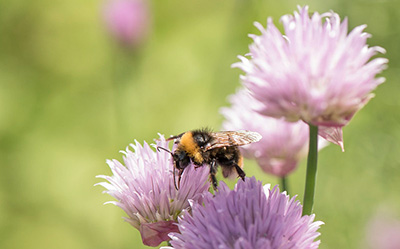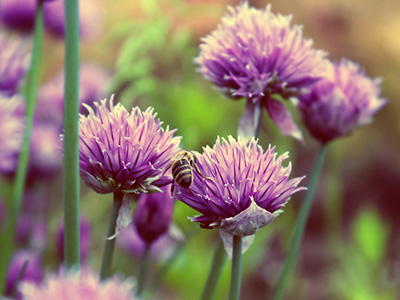Herbs for Pollinator Gardens
Did you know your herb garden can double as a pollinator garden?

Many of our favorite herbs make excellent nectar sources if they are allowed to flower. Some are even host plants for butterflies. Sharing a garden with pollinators does require a little adjusting, but we love the life it brings to a landscape.
Pollinator-friendly Herb Gardening
Over-plant and don’t pinch: Some herbs lose their punch when they’re allowed to flower. To avoid this, gardeners pinch off flower buds as they form. Instead, we suggest planting twice as much as you need and allowing half of your herbs to flower and let the rest go to seed. Yes, it will look a little untidy, but it will also be buzzing with happy pollinators.
Leave dead stems and bare ground: While not classically beautiful, dried stems and bare ground are perfect nesting sites for most of Florida’s native bees. If you leave the spent stems as nesting sites, wait until the warm weather returns to remove them. You can learn more in our article Gardening for Bees.
Pesticide-free zone: You can make your garden safe for pollinators by skipping pesticides whenever possible. Integrated pest management (IPM) offers plenty of other ways to help control pest populations. If you must apply chemical controls, read the labels carefully. Even “natural” products like Bt (Bacillus thuringiensis) can harm butterfly caterpillars. Finally, never spray during the day or when plants are flowering. These are the times when pollinators are most active.
Herbs for a pollinator garden
Here are a few of our favorite pollinator-friendly herbs:
Basil, Thai basil, marjoram, mint, oregano, and sage all produce flower spikes with dozens of blooms. Because flying requires huge amounts of energy, pollinators conserve it when they can. By visiting flowers that grow in clusters they spend less energy flying from bloom to bloom. Bees are especially interested in these clustered flowers.
Cilantro, dill, fennel, bronze fennel, and parsley are all host plants for swallowtail butterfly species. As host plants, they will end up covered in hungry, hungry caterpillars. Happily, this infestation is a good thing! If the sight of chewed plants is too unappealing, we suggest planting these toward the back of the butterfly garden.

Chives and garlic chives are good choices, too. Their bright, puffball flowers are attractive to pollinators and gardeners alike. While garlic would seem like an obvious addition, we don’t include it on this list because it is difficult to grow in Florida’s humid climate.
Like garlic, lavender struggles in our wet summer weather. Rosemary we omit as well. Rosemary grows well in Florida but it rarely flowers profusely enough for a pollinator garden.
However you decide to stock your pollinator and herb gardens, Extension agents and Master Gardener Volunteers are here to help. You can reach them at your county Extension office.
Also on Gardening Solutions
- Bird-Friendly Plants
- Gardening for Bees
- Gardening for Birds
- Gardening for Butterflies
- Perfect Plants for Pollinators
- Pesticides and Bees
- Pollinator Hotels
